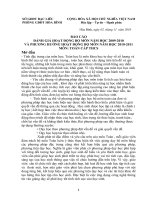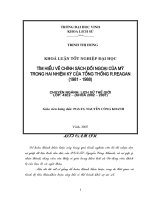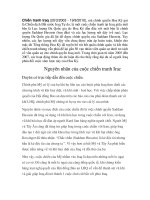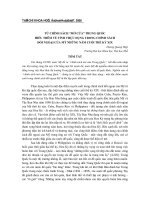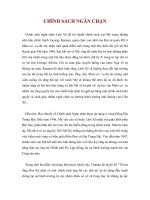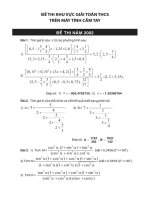great predictions grade 8 Bộ Sách Toán THCS Của Mỹ
Bạn đang xem bản rút gọn của tài liệu. Xem và tải ngay bản đầy đủ của tài liệu tại đây (2.92 MB, 69 trang )
Great
Predictions
Data Analysis and
Probability
CuuDuongThanCong.com
/>
Mathematics in Context is a comprehensive curriculum for the middle grades.
It was developed in 1991 through 1997 in collaboration with the Wisconsin Center
for Education Research, School of Education, University of Wisconsin-Madison and
the Freudenthal Institute at the University of Utrecht, The Netherlands, with the
support of the National Science Foundation Grant No. 9054928.
The revision of the curriculum was carried out in 2003 through 2005, with the
support of the National Science Foundation Grant No. ESI 0137414.
National Science Foundation
Opinions expressed are those of the authors
and not necessarily those of the Foundation.
Roodhardt, A., Wijers, M., Bakker, A., Cole, B. R., and Burrill, G. (2006). Great
Predictions. In Wisconsin Center for Education Research & Freudenthal Institute
(Eds.), Mathematics in context. Chicago: Encyclopædia Britannica, Inc.
Copyright © 2006 Encyclopædia Britannica, Inc.
All rights reserved.
Printed in the United States of America.
This work is protected under current U.S. copyright laws, and the performance,
display, and other applicable uses of it are governed by those laws. Any uses not
in conformity with the U.S. copyright statute are prohibited without our express
written permission, including but not limited to duplication, adaptation, and
transmission by television or other devices or processes. For more information
regarding a license, write Encyclopædia Britannica, Inc., 331 North LaSalle Street,
Chicago, Illinois 60610.
ISBN 0-03-038572-5
1 2 3 4 5 6 073 09 08 07 06 05
CuuDuongThanCong.com
/>
The Mathematics in Context Development Team
Development 1991–1997
The initial version of Great Expectations was developed by Anton Roodhardt and Monica Wijers.
It was adapted for use in American schools by Beth R. Cole and Gail Burrill.
Wisconsin Center for Education
Freudenthal Institute Staff
Research Staff
Thomas A. Romberg
Joan Daniels Pedro
Jan de Lange
Director
Assistant to the Director
Director
Gail Burrill
Margaret R. Meyer
Els Feijs
Martin van Reeuwijk
Coordinator
Coordinator
Coordinator
Coordinator
Sherian Foster
James A, Middleton
Jasmina Milinkovic
Margaret A. Pligge
Mary C. Shafer
Julia A. Shew
Aaron N. Simon
Marvin Smith
Stephanie Z. Smith
Mary S. Spence
Mieke Abels
Jansie Niehaus
Nina Boswinkel
Nanda Querelle
Frans van Galen
Anton Roodhardt
Koeno Gravemeijer
Leen Streefland
Marja van den Heuvel-Panhuizen
Jan Auke de Jong
Adri Treffers
Vincent Jonker
Monica Wijers
Ronald Keijzer
Astrid de Wild
Martin Kindt
Project Staff
Jonathan Brendefur
Laura Brinker
James Browne
Jack Burrill
Rose Byrd
Peter Christiansen
Barbara Clarke
Doug Clarke
Beth R. Cole
Fae Dremock
Mary Ann Fix
Revision 2003–2005
The revised version of Great Predictions was developed Arthur Bakker and Monica Wijers.
It was adapted for use in American Schools by Gail Burrill.
Wisconsin Center for Education
Freudenthal Institute Staff
Research Staff
Thomas A. Romberg
David C. Webb
Jan de Lange
Truus Dekker
Director
Coordinator
Director
Coordinator
Gail Burrill
Margaret A. Pligge
Mieke Abels
Monica Wijers
Editorial Coordinator
Editorial Coordinator
Content Coordinator
Content Coordinator
Margaret R. Meyer
Anne Park
Bryna Rappaport
Kathleen A. Steele
Ana C. Stephens
Candace Ulmer
Jill Vettrus
Arthur Bakker
Peter Boon
Els Feijs
Dédé de Haan
Martin Kindt
Nathalie Kuijpers
Huub Nilwik
Sonia Palha
Nanda Querelle
Martin van Reeuwijk
Project Staff
Sarah Ailts
Beth R. Cole
Erin Hazlett
Teri Hedges
Karen Hoiberg
Carrie Johnson
Jean Krusi
Elaine McGrath
CuuDuongThanCong.com
/>
(c) 2006 Encyclopædia Britannica, Inc. Mathematics in Context
and the Mathematics in Context Logo are registered trademarks
of Encyclopædia Britannica, Inc.
Cover photo credits: (left, middle) © Getty Images; (right) © Comstock Images
Illustrations
8 Holly Cooper-Olds; 12 James Alexander; 17, 18, 24 Holly Cooper-Olds;
28, 29 James Alexander; 34, 36, 40 Christine McCabe/© Encyclopædia Britannica,
Inc.; 44 Holly Cooper-Olds
Photographs
1 Photodisc/Getty Images; 2 © Raymond Gehman/Corbis; 3 USDA Forest Service–
Region; 4 Archives, USDA Forest Service, www.forestryimages.org; 7 © Robert
Holmes/Corbis; 16 laozein/Alamy; 18 © Corbis; 30 Victoria Smith/HRW;
32 Epcot Images/Alamy; 36 Dennis MacDonald/Alamy; 39 Creatas;
42 (left to right) © PhotoDisc/Getty Images; © Corbis; 44 Dennis MacDonald/
Alamy; 45 Dynamic Graphics Group/ Creatas/Alamy; 47 © Corbis
CuuDuongThanCong.com
/>
Contents
Letter to the Student
Section A
Drawing Conclusions from Samples
Chance or Not?
Taking Samples
Populations and Sampling
Summary
Check Your Work
Section B
24
28
30
30
Expectations
Carpooling
Advertising
Expected Life of a Mayfly
Free Throws
Summary
Check Your Work
Section E
12
16
17
18
20
21
Reasoning From Samples
Fish Farmer
Backpack Weight
Summary
Check Your Work
Section D
1
4
8
10
10
Maybe There is a Connection
Opinion Poll
Insect Repellent
Ape Shapes
Glasses
Summary
Check Your Work
Section C
vi
32
34
36
36
38
38
Combining Situations
Free Meal
Delayed Luggage
Summary
Check Your Work
40
45
48
49
Additional Practice
50
Answers to Check Your Work
55
Contents v
CuuDuongThanCong.com
/>
Dear Student,
Welcome to Great Predictions!
Surveys report that teens prefer
brand-name jeans over any other
jeans.
Do you think you can believe all the conclusions that are reported as
“survey results”? How can the results be true if they are based on
the responses of just a few people?
In this unit, you will investigate how statistics can help you study,
and answer, those questions. As you explore the activities in this
unit, watch for articles in newspapers and magazines about surveys.
Bring them to class and discuss how the ideas of this unit help you
interpret the surveys.
When you finish Great Predictions, you will appreciate how people
use statistics to interpret surveys and make decisions.
Sincerely,
The Mathematics in Context Development Team
vi Great Predictions
CuuDuongThanCong.com
/>
A
Drawing Conclusions
from Samples
Chance or Not?
How Do Television Networks Rate Their Programs?
People often complain about the number of commercials aired during
their favorite television program, but the money brought in by these
commercials pays the majority of the cost of producing the program.
The cost of airing a commercial during a television program largely
depends on the current rating of the program. Popular television
programs often charge top dollar for a one-minute commercial spot,
while less popular programs charge less money. Therefore, television
networks look closely at each program’s rating on a weekly basis.
The rating for a particular show is the percent of households with TVs
that watch the show. How do the major television networks determine
who is watching what program?
Section A: Drawing Conclusions from Samples 1
CuuDuongThanCong.com
/>
A Drawing Conclusions from Samples
At one time, independent survey companies asked a large sample of
people to complete a diary in which they listed all the programs they
watched each week. For example, in a city with 297,970 households
with TVs, the survey company might have 463 households keep diaries.
1. a. Why didn’t survey companies give a diary to every household?
b. How do you think survey results could be used to estimate the
overall popularity of television programs?
c. Suppose that 230 of the 463 surveyed households watched the
Super Bowl. How would you estimate the total number of
households in that city that watched the Super Bowl?
d. How reliable do you think the estimate would be?
A Forest at Risk
In a forested area near Snow Creek, an
average of 12 trees per 10 acres died from
severe weather conditions over the last
several years. But this year from January
to August, forest rangers reported about
42 dead or dying trees per 10 acres.
2. a. The forest near Snow Creek is
about 5,000 acres. How many
trees would you normally expect
to die from storms in the area?
b. Explain whether you think the
foresters should be concerned
about the health of the trees.
Many insects and diseases are an important part of creating healthy
and diverse patterns of vegetation in the forests, even though they
sometimes kill or stunt large patches of trees. In addition, trees are
often stressed by weather conditions (too much or too little water, for
example) and die.
In many areas of the Rocky Mountains, the forest rangers found
clusters of trees scattered throughout the forests that were dying.
They discovered that the trees were infested by a beetle that burrows
into the bark.
2 Great Predictions
CuuDuongThanCong.com
/>
Drawing Conclusions from Samples A
The mountain pine beetle is the most aggressive
and destructive insect affecting pine trees in
western North America. Pine beetles are part of
the natural cycle in forests. Recent evidence
indicates that in certain regions, mountain pine
beetle populations are on the rise.
In the Rocky Mountains, more trees were dying than was normally
expected.
3. a. Reflect The number of dead or dying trees seemed to be
different in certain areas, for example in Snow Creek and the
Rocky Mountains. What may have caused this difference?
b. What do you think foresters do to support their case that
the change in the number of damaged and dying trees is
something to watch?
There is a similarity between the two examples presented in questions
2 and 3. In each case, an important question is being raised.
When is a difference from an expected outcome a coincidence (or due
to chance), and when could there be another explanation that needs
to be investigated?
Keep this question in mind throughout this section as you look at
other situations. For the example about Snow Creek, the high number
of death or dying trees seemed to be a coincidence, while there
seemed to be an explanation for the high rate of dying trees in the
Rocky Mountains.
For each of the following situations, the result may be due to chance
or perhaps there is another explanation. For each situation, give an
explanation other than chance. Then decide which cause you think is
more likely, your explanation or chance.
4. a. A basketball player made eleven free throws in a row.
b. Each of the last seven cars that drove past a school was red.
c. In your town, the sun has not been out for two weeks.
d. On the drive to school one morning, all the traffic lights were
green.
e. All of the winners of an elementary school raffle were
first-graders.
Section A: Drawing Conclusions from Samples 3
CuuDuongThanCong.com
/>
A Drawing Conclusions from Samples
5. Reflect If something unusual happened in your life, how would
you decide whether it was due to chance or something else?
Give an example.
Taking Samples
Here are some terms that are helpful when you want to talk about
chance.
A population is the whole group in which you are interested.
A sample is a part of that population.
In a town of 400 people, 80 subscribe
to the local newspaper. This could be
represented in a diagram in which
80 out of 400 squares have been filled
in randomly. So the red squares
represent the subscribers.
A researcher wants to take a random sample of ten people from
the population in the town. You are going to simulate taking the
sample by using the diagram on Student Activity Sheet 1.
Close your eyes and hold your pencil over the diagram on
Student Activity Sheet 1. Let the tip of your pencil land lightly
on the diagram. Open your eyes and note where the tip landed.
Do this experiment a total of 10 times, keeping track of how many
times you land on a black square. The 10 squares that you land on
are a sample.
4 Great Predictions
CuuDuongThanCong.com
/>
Drawing Conclusions from Samples A
6. a. Do you think that, in general, there is a better chance of
landing on a white square or on a black square?
b. What is the chance (probability) of landing on a black square?
How did you calculate the chance?
c. Organize the samples from the entire class in a chart like the
one shown.
d. Look carefully at the chart below and describe what this tells
you about the random samples. How well do the samples
reflect the overall population with respect to the subscribers
to the newspaper?
Number of
Black Squares
in 10 Tries
Number of
Students Who
Get This Number
0
1
2
3
4
5
6
7
8
9
10
Section A: Drawing Conclusions from Samples 5
CuuDuongThanCong.com
/>
A Drawing Conclusions from Samples
It can be difficult to draw a conclusion about a population from a
sample. Consider the following problem, in which members of a
population are represented by squares.
Each of the samples was taken from one of three different populations.
Population A has 200 red squares out of 1,000. Population B has 300
red squares out of 1,000, and Population C has 500 red squares out
of 1,000.
i
ii
iii
iv
v
vi
vii
viii
7. a. For each sample, decide whether you think it belongs to
Population A, Population B, or Population C. Explain why
you made each decision. What is the size of each sample?
b. Which samples do you find the most difficult to classify? Why
are these difficult?
c. What do you think is the problem with making a conclusion
based on a sample?
6 Great Predictions
CuuDuongThanCong.com
/>
Drawing Conclusions from Samples A
Who Prefers Which Yogurt?
Tara is trying to determine whether students at her school prefer
vanilla, banana, or strawberry yogurt. She asks four friends and
records their preferences. Based on their preferences Tara decides
that half the school prefers strawberry, 25% prefer vanilla, and 25%
prefer banana.
Carla is interested in the same question. She stands at the door as
students are leaving school and asks 50 students which flavor they
prefer. She decides that 22% prefer strawberry, 26% prefer vanilla,
and 52% prefer banana.
8. a. How did Tara and Carla come up with the percentages?
b. Reflect If you were ordering the yogurt for the school picnic,
on whose results would you base your order, Tara’s or Carla’s?
Why?
Who’s Going to the Zoo?
Suppose you are the director of a zoo and you
are having students in the area attend the
grand opening of a new primate center.
There are five schools in your area, each with
300–500 students, but you know that not every
student will be able to attend. You randomly
choose 20 students from each school and ask
whether they would be interested in attending.
Your survey results suggest that 30 students
say that they will attend, and 70 students say
that they will not attend.
9. a. If 2,000 students live in the area, how
many would you expect to come to the
grand opening?
b. Reflect To plan the grand opening,
what else do you need to know?
In the zoo problem, you could not know the percent of students in the
population who would attend, so you needed a sample to estimate
the percent.
10. To answer problem 9a, you probably assumed that the sample and
the population had the same percentage of students who wanted
to attend the opening. How reasonable is this assumption?
Section A: Drawing Conclusions from Samples 7
CuuDuongThanCong.com
/>
A Drawing Conclusions from Samples
Who Was in the House?
The illustration represents the U.S. House of Representatives during a
session. The House has 435 members. You can see from the empty
chairs that some members were missing.
11. a. Explain why the illustration represents a sample of the
members of the U.S. House of Representatives.
b. You may assume that this sample is randomly chosen. How
many members do you think attended the session?
Populations and Sampling
What Kind of Music Do You Like?
Natasha and David think that the school should play music in the
cafeteria during lunch. The principal agrees that it is a good idea and
tells David and Natasha to find out what kind of music the students
want. The two decide to survey the students in their next classes and
also to ask anyone else they happen to meet in the halls. Natasha
goes to band class, and David goes to his computer class. Natasha
and David present the results of their survey to the principal.
12. Write a brief note to the principal explaining why the results of
the survey of Natasha and David should not be used to make a
decision about what kind of music to play in the cafeteria.
8 Great Predictions
CuuDuongThanCong.com
/>
Drawing Conclusions from Samples A
NEWS WATCH: DATA POINT;
For the Music Lover, Gray Hair Is No Barrier to White Earbuds
By MARK GLASSMAN
Published: February 17, 2005
Youthful silhouettes rocking out
may be the new fresh faces of portable
digital music, but—shh!— grown-ups
are listening, too.
Roughly one in nine Americans 18 or
older has an iPod or an MP3 player,
according to survey results released this
week by the Pew Internet and American
Life Project.
Younger adults were the most likely
group to own the devices. Roughly one
in five people 18 to 28 years old said
they had a music player. About 2 percent
of those 69 and over reported owning
one.
“It’s obviously just now reaching the
tipping point as a technology,” Lee
Rainie, the project director, said of
digital music players. “I would think
that we’ll even have accelerating
growth over the next year or two.” He
said more adults would probably buy
the devices “as more players come
into the market; as the price point rolls
down; as Apple itself rolls out new
products.”
The survey, drawing on responses
of 2,201 people by telephone, also
revealed a small gender gap, with more
men (14 percent) owning the devices
than women (9 percent). “Look at any
technology deployment over the last
century and a half,” Mr. Rainie said.
“Men tend to be dominant early on,
and women tend to catch up.”
Source: New York Times, February 17, 2005
13. a. What population was studied in the article?
b. Describe the sample taken: do you think this is a good sample?
Why or why not?
c. Do you think you can believe the claim made in the second
paragraph of the article: “Roughly one in nine Americans 18 or
older has an iPod or an MP3 player.” Explain your reasoning.
d. How do you think the results will be different if this study were
to be repeated 5 years from now?
Section A: Drawing Conclusions from Samples 9
CuuDuongThanCong.com
/>
A Drawing Conclusions from Samples
Drawing conclusions from samples always involves uncertainty.
In the case of the television ratings, it would take too much time and
cost too much money to find the exact number of people who watch
a certain program. Instead, information from a random sample can
be used to deduce information about the whole group. By doing this,
you introduce uncertainty.
Information from a sample drawn from a population may or may not
be what you would expect about the population. If a sample seems
unusual, you have to think about whether there could be an explanation
or whether the difference is due to chance. In Snow Creek the higher
number of damaged trees seemed to be due to chance, but in the
Rocky Mountains the unusual high number of damaged trees could be
explained by the increasing numbers of mountain pine beetles.
Sample results can be affected by the way questions are asked and
the way the sample was selected.
When taking a sample, it is important to do so randomly so that every
different possible sample of the size you want from the population
has the same chance of being selected.
Bora Middle School has a total of 250 students. A survey about pets
was conducted at the school. Sixty percent of the students have one
or more pets.
1. How many students in Bora Middle School have one or more
pets?
10 Great Predictions
CuuDuongThanCong.com
/>
Claire asked 20 students in her sixth-grade science class if they have
any pets.
2. a. How many of the 20 students do you expect answered “yes”?
Explain.
b. It turned out that 16 out of the 20 students that Claire surveyed
have one or more pets. Does this result surprise you? Why or
why not?
c. Why do you think so many students in Claire’s science class
have pets?
3. a. If Claire had asked 200 students at Bora Middle School instead
of 20, how many would you expect to have pets?
b. Would you be surprised if Claire told you she found that 160
out of the 200 have pets? Explain your answer.
4. Suppose you want to know how many students in your school
have pets. You cannot take a survey or ask all students. In what
way would you select a sample to find out how many students
in your school have pets? Give reasons for your answer.
When sampling is done to rate television programs, the poll takers
do not take a random sample of the entire population. Instead they
divide the population into age groups. What are some of the reasons
why they might do this?
Section A: Drawing Conclusions from Samples 11
CuuDuongThanCong.com
/>
B
Maybe There Is a
Connection
Opinion Poll
Next month, the citizens of Milo will vote on the following referendum.
Question: Should the city of Milo construct a second bridge
between the east and west districts?
The local newspaper organized an opinion poll using a sample of
the city’s residents. The diagram on the next page shows the results.
Each square represents a person who took part in the poll and shows
approximately where he or she lives. A white square means that the
person plans to vote “no,” and a green square indicates that the
person plans to vote “yes.”
12 Great Predictions
CuuDuongThanCong.com
/>
Maybe There is a Connection B
Bridge
River
West District:
200 Citizens Polled
East District:
100 Citizens Polled
1. a. Do you think a majority of the citizens will vote for a new bridge?
Make an estimate from the diagram to support your answer.
b. Based on the sample, what is the chance that someone who
lives in the west district will vote “yes”?
You might wonder whether there is a connection between where
people live and how they plan to vote.
2. a. Count the actual responses to the bridge poll as shown in the
diagram. Use a two-way table like the one shown to organize
your numbers.
West
East
Total
200
100
300
Yes
No
Total
b. Which group of people, those in the east district or those in the
west district, seem to be more in favor of the bridge?
c. Do you think that there is a connection in the town of Milo
between where people live and how they plan to vote?
Explain your reasoning.
Section B: Maybe There is a Connection 13
CuuDuongThanCong.com
/>
B Maybe There is a Connection
Yes
West
Vote
No
Population
Place person lives
Yes
East
Vote
No
You can separate the 300 members of the sample into two groups:
those who live in the west district and those who live in the east
district. You can subdivide each of the two groups into two more
groups: those who plan to vote “yes” and those who plan to vote
“no,” for a total of four groups. You can describe this situation
using a tree diagram.
Because it is not possible to draw a branch for each person in the
sample, branches are combined in such a way that you have two
branches, one for the people living in the west district and one for
the people in the east.
3. a. What number of people does the branch for people living in
the west district represent?
b. Redraw the tree-diagram, filling in each of the boxes with the
appropriate number from problem 2.
c. Reflect Which method—a two-way table or a tree diagram—
seems more helpful to you for finding out whether there is a
connection between where people live and how they will vote?
Give a reason for your choice.
14 Great Predictions
CuuDuongThanCong.com
/>
Maybe There is a Connection B
There are two possibilities for voting on the Milo bridge.
i. There is no connection between where people live and how
they will vote. In other words, the two factors, or “events,” are
independent. Another way to think about this is that the chance
of a “yes” vote is the same for all citizens, no matter on which
side of the river they live.
ii. There is a connection. The two events are dependent. In this
case, how a person votes is affected by where the person lives.
4. For voting on the Milo bridge, which possibility seems more likely
to you, possibility i or ii? Give a reason for your choice.
If the events are dependent, sometimes you can explain the connection
by looking carefully at the situation.
5. Reflect What are some reasons that people on different sides of
the river might vote differently on the Milo bridge?
Now let’s suppose there is no connection between where people live
and how they will vote. In other words, those events are independent.
In the first column of the two-way table below, you can see how
people in the west district voted.
West
Yes
120
No
80
Total
200
East
Total
100
300
6. a. Assuming that the events “where a person lives” and “how
that person votes” are independent, how many people from
the east district have voted “yes” and how many have voted
“no”? Copy and complete the table. Explain how you got your
answer.
b. Reflect In general, how can you use the numbers in a table
or diagram to decide whether two events are dependent or
independent? Hint: Use the word ratio or percent in your
answer.
Section B: Maybe There is a Connection 15
CuuDuongThanCong.com
/>
B Maybe There is a Connection
Insect Repellent
A new insect repellent was tested to see whether it prevents
mosquito bites. It was not feasible to test the repellent on the
entire U.S. population, so the researchers used a sample.
Because mosquitoes may be different in different parts of
the country, the researchers ran the test in four different
geographical regions. A sample of people was selected from
each region and divided into two groups. Each person received
a bottle of lotion. For one group, the lotion contained the new
repellent, and for the other group, the lotion had no repellent.
The people in each group did not know whether or not they
received the repellent.
7. Why do you think the test was designed in such a
complicated way?
The researchers ran the insect repellent test in four parts of the
country and summarized the results.
Region II
Region I
R
NR
B
41
53
94
NB
79
27
106
80
200
Totals
120
R
NR
Totals
B
70
58
128
NB
40
32
72
90
200
Totals
Totals
110
Region IV
Region III
KEY:
R ؍Repellent
NR ؍No Repellent
B ؍Bitten
NB ؍Not Bitten
B
NB
Totals
R
NR
Totals
100
49
149
30
21
51
130
70
200
B
NB
Totals
R
NR
Totals
50
61
111
60
29
89
110
90
200
8. a. How many people were used for the sample from Region I?
b. In Region I, explain what the numbers 120, 41, and 79 represent.
c. What is the chance that a randomly selected person from the
sample in Region 1 was bitten?
d. Would you change your answer to c, if you were told the person
had used repellent?
9. If you knew people living in each of the four parts of the country,
who would you encourage to use the repellent and who would
you discourage? Explain your advice; use chance in your
explanation.
16 Great Predictions
CuuDuongThanCong.com
/>
Maybe There is a Connection B
Ape Shapes
Koko is an orangutan at the zoo. She is allowed to play with blocks
that come in three shapes—cylinders, cubes, and pyramids. They
also come in two colors—blue and orange. Here are 40 blocks that
Koko took out of a bucket full of blocks.
10. a. If Koko randomly chooses one of her 40 blocks, what is the
chance that it will be a cube?
b. What is the chance that the block Koko chooses will be blue?
The zookeepers wonder whether there is a connection between the
shape of a block and its color for the blocks Koko chose. In other
words, does Koko like blue cubes better than orange ones? Orange
cylinders better than blue ones? And so on.
The first step in answering this question is to organize the data.
Total
Blue
Orange
Total
11. a. Copy the two-way table and record the
information about the 40 blocks Koko
has chosen.
b. Is there a connection between block
shape and color? How did you decide?
Section B: Maybe There is a Connection 17
CuuDuongThanCong.com
/>
B Maybe There is a Connection
Koko and the zookeeper play a game with some
zoo visitors. Koko picks up one of her 40 blocks
and shows it to the visitors. The zookeeper, who
is blindfolded, guesses the color.
The zookeeper guesses orange.
12. What is the chance that she is right?
During the game, one of the zoo visitors says that the shape Koko
chose is a cube.
Again, the zookeeper guesses orange.
13. What is the chance that she is right this time?
The information that the shape is a cube changes the situation
because now there are fewer possible blocks; in other words, it
changes the chance that the block is orange.
14. What shape can Koko choose that will give the zookeeper the
least help in guessing the color? Explain.
Glasses
In this two-way table, you see data on people
wearing glasses. The data are from a sample
of 130 people.
Men
Women
Total
Glasses
32
3
35
No Glasses
56
39
95
Total
88
42
130
18 Great Predictions
CuuDuongThanCong.com
/>
Maybe There is a Connection B
A person from this sample is chosen at random.
15. a. What is the chance that the person wears glasses?
b. If you were told that the person is a woman, would you change
your answer for part a? How?
The data from the table can be used to make a tree diagram.
16. Copy and complete the tree diagram by filling in the correct
numbers in the boxes.
Glasses
Man
68%
No
Glasses
130
Woman
Glasses
No
Glasses
You can make the tree diagram into a chance tree by listing the chance,
or probability, for each event. The chances are written next to the
arrows. For example, the chance that a person from the sample is a
man is 68%.
17. a. Explain how the 68% was calculated from the data in the table.
b. Fill in the chance for each event in your tree diagram.
c. Use the tree diagram to find the chance a randomly selected
person from this sample is a man wearing glasses.
18. a. Reflect Explain how you can use the chance tree to conclude
that wearing glasses is dependent on whether the person is a
man or a woman.
b. What would your chance tree look like if wearing glasses was
independent of being a man or a woman?
Section B: Maybe There is a Connection 19
CuuDuongThanCong.com
/>

